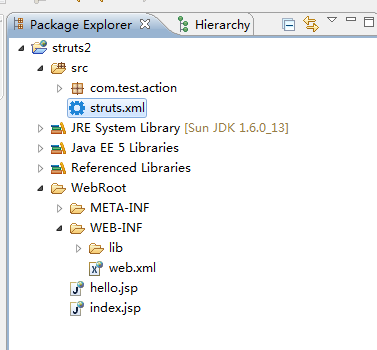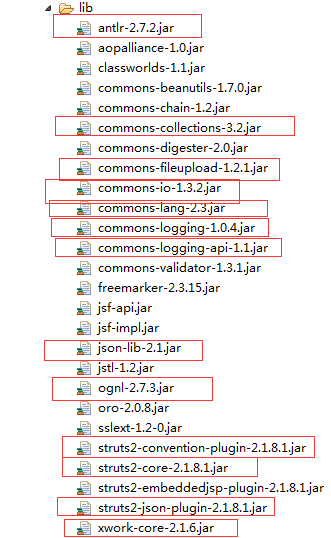工具:myeclipse、struts2 jar包(官网下或者myeclipse自带)
1、新建一个web project
2、导入所需jar包
在lib中导入如下包(标红的为必需的与常用的),复制到lib文件夹下即可。
3、编写web.xml
<?xml version="1.0" encoding="UTF-8"?>
<web-app version="2.5"
xmlns="http://java.sun.com/xml/ns/javaee"
xmlns:xsi="http://www.w3.org/2001/XMLSchema-instance"
xsi:schemaLocation="http://java.sun.com/xml/ns/javaee
http://java.sun.com/xml/ns/javaee/web-app_2_5.xsd">
<welcome-file-list>
<welcome-file>index.jsp</welcome-file>
</welcome-file-list>
<filter>
<filter-name>struts2</filter-name>
<filter-class>
org.apache.struts2.dispatcher.ng.filter.StrutsPrepareAndExecuteFilter
</filter-class>
</filter>
<filter-mapping>
<filter-name>struts2</filter-name>
<url-pattern>/*</url-pattern>
</filter-mapping>
</web-app>4、编写 struts.xml
在src文件夹下新建struts.xml。并写入以下代码:
<?xml version="1.0" encoding="UTF-8" ?>
<!DOCTYPE struts PUBLIC "-//Apache Software Foundation//DTD Struts Configuration 2.1//EN" "http://struts.apache.org/dtds/struts-2.1.dtd">
<struts>
<package name="default" namespace="/" extends="struts-default">
<action name="hello" class="com.test.action.HelloAction">
<result name ="success">/hello.jsp</result>
</action>
</package>
</struts> 5、编写action类
如图:在src下新建包com.test.action,并编写HelloAction.java类。
HelloAction.java
package com.test.action;
import com.opensymphony.xwork2.ActionSupport;
public class HelloAction extends ActionSupport {
/**
*
*/
private static final long serialVersionUID = 1L;
@Override
public String execute() throws Exception {
// TODO Auto-generated method stub
System.out.println("hello");
return SUCCESS;
}
}6、编写前台jsp页面
在WebRoot文件夹下编写hello.jsp及index.jsp
index.jsp
<%@ page language="java" import="java.util.*" pageEncoding="ISO-8859-1"%>
<%
String path = request.getContextPath();
String basePath = request.getScheme()+"://"+request.getServerName()+":"+request.getServerPort()+path+"/";
%>
<!DOCTYPE HTML PUBLIC "-//W3C//DTD HTML 4.01 Transitional//EN">
<html>
<head>
<base href="<%=basePath%>">
<title>My JSP 'index.jsp' starting page</title>
<meta http-equiv="pragma" content="no-cache">
<meta http-equiv="cache-control" content="no-cache">
<meta http-equiv="expires" content="0">
<meta http-equiv="keywords" content="keyword1,keyword2,keyword3">
<meta http-equiv="description" content="This is my page">
<!--
<link rel="stylesheet" type="text/css" href="styles.css">
-->
</head>
<body>
<form action = "hello">
<input type="submit" value = "submit"/>
</form>
</body>
</html>hello.jsp
<%@ page language="java" import="java.util.*" pageEncoding="ISO-8859-1"%>
<%
String path = request.getContextPath();
String basePath = request.getScheme()+"://"+request.getServerName()+":"+request.getServerPort()+path+"/";
%>
<!DOCTYPE HTML PUBLIC "-//W3C//DTD HTML 4.01 Transitional//EN">
<html>
<head>
<base href="<%=basePath%>">
<title>My JSP 'hello.jsp' starting page</title>
<meta http-equiv="pragma" content="no-cache">
<meta http-equiv="cache-control" content="no-cache">
<meta http-equiv="expires" content="0">
<meta http-equiv="keywords" content="keyword1,keyword2,keyword3">
<meta http-equiv="description" content="This is my page">
<!--
<link rel="stylesheet" type="text/css" href="styles.css">
-->
</head>
<body>
hello<br>
</body>
</html>7、部署工程到服务器上
将工程部署到tomcat等服务器上,在浏览器输入index.jsp

点击按钮即跳转到hello.jsp
结束!




























 被折叠的 条评论
为什么被折叠?
被折叠的 条评论
为什么被折叠?








